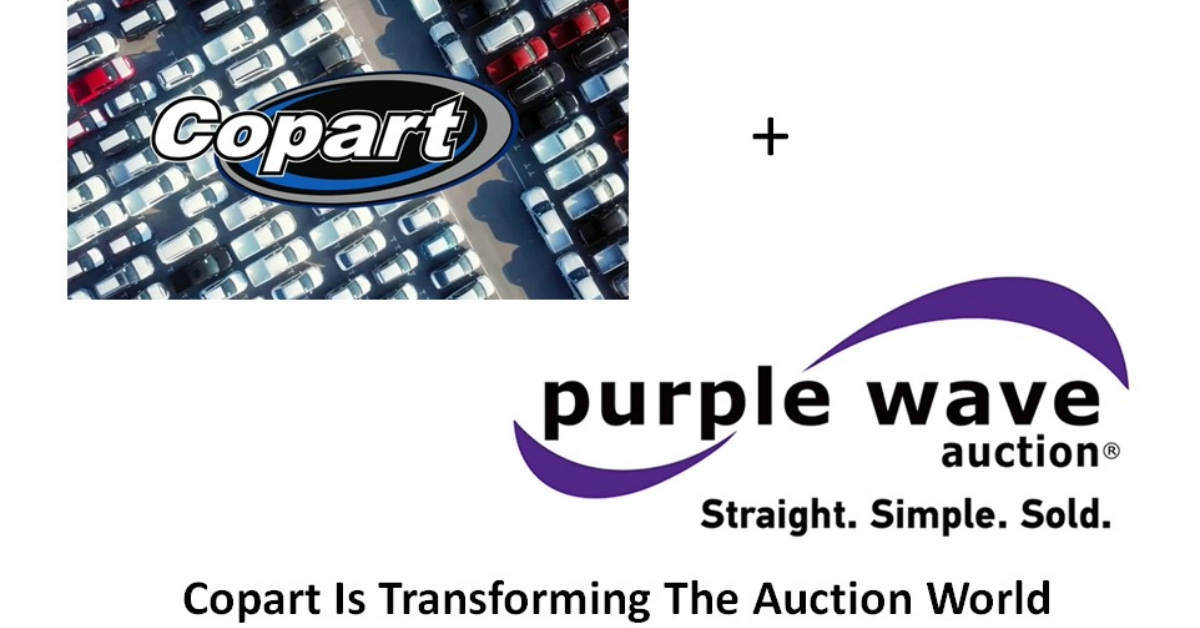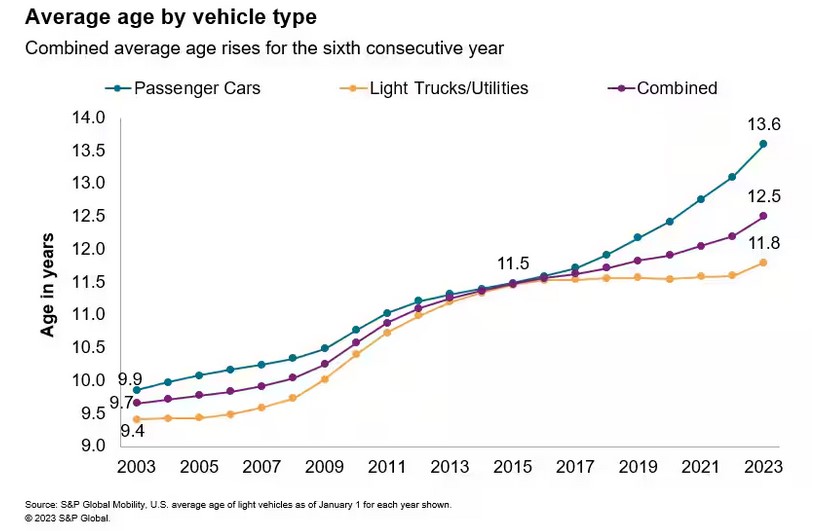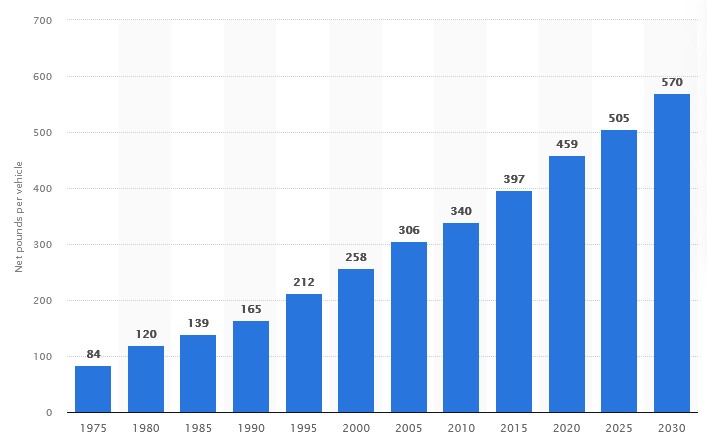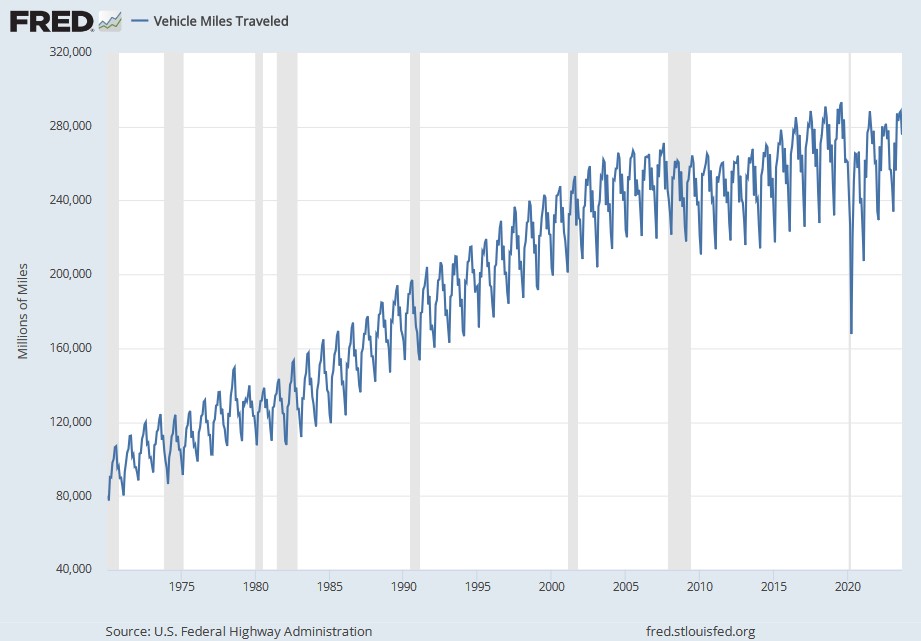Contents

When I last reviewed Copart (CPRT) in this September 16, 2023 post, it had just released its FY2023 results. On October 10, Copart announced that it is transforming the auction world with the acquisition of a majority interest in Purple Wave, an online heavy equipment auction company.
Now that we have CPRT's Q1 2024 financial results, I revisit this existing holding.
Business Overview
Investors unfamiliar with CPRT should look at the company's website and Part 1 of the FY2023 Form 10-K.
CPRT was founded in 1982 (see timeline). It has, however, held all auctions online since 2003. This enables it to connect buyers and sellers across the globe.
It is the largest online salvage vehicle auction operator in the United States with nearly five-fold top-line growth since 2009.
It receives the majority of its vehicle volume through contracts with large auto insurers and sells them on consignment for high margins. The reason CPRT is so successful is that it maintains very strong insurance relationships by offering adequate storage capacity and being a flexible service provider.
CPRT conducts business primarily in the US but is expanding internationally; a list of locations is accessible here.
It has also integrated itself into the salvage vehicle resale process by emphasizing its ancillary service offerings such as vehicle title transfer and salvage estimation services.
In my November 8 post, I recommended several books worth reading. One such book is Junk to Gold - Lessons I Learned (Copart). Throughout the book, Willis Johnson, the founder of CPRT, stresses the importance of strong customer service. This means having plentiful land capacity and adequate staffing levels to handle an influx of salvage vehicle volume on short notice.
Since 2015, CPRT has more than doubled its total acreage and emphasized expanding capacity in areas at high risk of suffering from natural disasters in the southern U.S. In 2017, CPRT took assignment of over 90,000 damaged vehicles from Hurricane Harvey by temporarily leasing additional swaths of land and contracting with numerous towing companies.
CPRT has a huge advantage over its competitors and new entrants in that it operates in excess of 17,000 acres of land (90% owned, 10% leased) of which ~20%-25% of owned acreage is often sitting idle at any given time. This 'idle land' is what allows CPRT to quickly absorb capacity after a major disaster. Any potential new entrants face if they attempt to purchase land or the rights to operate on land. Furthermore, finding suitable land that is allowed to be zoned as vehicle storage yards is another entry barrier.
At FYE2023 (July 31), the land held on CPRT's Balance Sheet totalled ~$1.812B (page 70 in the FY2023 Form 10-K) which was just shy of 27% of CPRT's total assets. CPRT, however, has been acquiring land for decades and the land value reflected on the Balance Sheet is likely much lower than fair market value.
Some CPRT competitors choose to lease land versus outright ownership. Not only do these competitors not benefit from the long-term appreciation in land value, but they are also at a disadvantage because they need to regularly renegotiate lease terms and compete with more lucrative uses of the leased land for landowners.
Look at the CPRT images to see how many vehicles are in some of the yards. Imagine if you lease acreage and fail to renegotiate your lease with the property owner. The cost of having to find new acreage and to relocate everything would be extremely costly.
Growing The Seller Base
Insurance companies are CPRT's primary sellers of vehicles. CPRT, however, is expanding its 'seller base' (ie. banks, finance companies, charities, fleet operators, dealers, vehicle rental companies, and individuals).
CPRT continues to grow its Blue Car business which specifically serves the bank and finance fleet and rental sellers. In Q1 2024, CPRT reported YoY growth of +35%. It increased its dealer sales volume by more than 13% YoY.
This ongoing growth in these noninsurance customer segments illustrates CPRT's ability to leverage its scale and technology thus maximizing auction liquidity and ultimately, returns for all involved.
In addition to gains in the insurance and noninsurance passenger vehicle space, CPRT continues to grow its specialty equipment business.
Purple Wave Investment
On October 10, CPRT announced that it had acquired a majority stake in Purple Wave, Inc., a privately owned online offsite heavy equipment auction company. The founders (Aaron and Suzy McKee) continue to retain a meaningful economic share.
Purple Wave, headquartered in Manhattan, Kansas, specializes in selling used agriculture, construction and fleet equipment. It operates a digital-only platform with a very limited real estate presence. It acts as an agent of the seller and delivers full auction services, including creating effective asset listings, bidder development and relationship management, and planning, creating and placing robust event advertising.
A search through the company's website reflects several similarities with the manner in which CPRT conducts business (online auction).
On March 20, 2023, RB Global, Inc. (RBA) (formerly Ritchie Bros. Auctioneers Incorporated) completed its acquisition of IAA, Inc. RBA specialized in heavy equipment auctions while IAA specialized in auto auctions.
I suspect CPRT's new strategic investment and partnership may one day lead to CPRT acquiring Purple Wave outright thus enabling it to compete with RB Global (RBA) across a variety of asset classes, including automotive, commercial transportation, construction, government surplus, lifting and material handling, energy, mining and agriculture.
I would not remotely consider investing in RBA since Moody's and S&P Global assign a domestic unsecured long-term debt rating of BA2 and BB+ to RB Global. Both ratings are two tiers below the lowest investment grade rating. As an equity investor, my risk would be rated highly speculative since my risk would be higher than that of an unsecured long-term debt holder.
What would possess an investor to invest in RBA when CPRT, on the other hand, has no net debt?
Partnership with Hi Marley
CPRT's September 12 Press Release explains how CPRT and Hi Marley plan to develop products that reduce the number of manual interactions needed to resolve automotive total loss claims.
Financials
Q1 2024 Results
CPRT's Q1 Form 10-Q is not yet available. I, therefore, reference its Form 8-K.
CPRT's Q1 2024 general and administrative expenditures, excluding stock-based compensation and depreciation expenses, were ~$57.6 million versus ~$44.5 million in Q1 2023. This ~$13.1 million increase includes $3 million due to a one-time maintenance project, the financial consolidation of Purple Wave into CPRT's results.
Total Loss Frequency (TLF)
A key metric CPRT monitors closely is TLF; management often states their key industry metrics are:
- miles driven;
- accident rate; and
- salvage rate.
TLF reflects the frequency in which a car accident is likely to lead to a car being considered a total loss. Influencing factors are the cost of repairing cars and the value of used cars. Combine the number of vehicles driven and the number of accidents and we get a pretty good idea of where this market is heading.
On the Q1 2024 earnings call, CPRT stated:
We continue to believe that total loss frequency will revert in time to historical levels and eventually well beyond in keeping with all recorded history on this statistic.
Our continued expectation is that new and used vehicle prices are likely to stabilize, perhaps decrease more. And if and when they do, to do so more steeply than repair costs will, driving an ongoing recovery in total loss frequency.
For the third calendar quarter of 2023 specifically, we observed a 4% decline in the Manheim used vehicle value index, while accident severity increased by 4% over that same period as reported by ISS Fast Track.
Although our U.S. insurance volumes continued to increase, up 9.7% year-over-year for the quarter, we estimate the total loss volumes continue to remain suppressed when compared to historical total loss frequency norms. And then as you've heard us say before, a brief reminder on the long-term drivers of total loss frequency.
First, vehicles become more expensive to repair with rising vehicle complexity, advanced components on the perimeter of vehicles in particular, rising labor costs and parts prices. And then just as importantly, a rising demand for mobility in growing economies and our auction platform and marketing efforts accessing those prospective buyers.
Total loss frequency in 2010 was ~15%. It bottomed at ~14% in 2013 and 2014. However, after 2014, TLF has been on a tear. TLF troughed slightly above 17% in Q2 2022 and is now ~19.3% according to CCC Intelligent Solutions Inc. in Q3 2023. Despite this increase, TLF remains substantially below pre-COVID highs of 21.7% in Q4 2020.
The higher the percentage, the greater the likelihood of an accident leading to a total loss and the more likely a car is sent to CPRT's auction service.
Furthermore, an older car is much more likely to be considered a total loss because the value is often much less than the cost to repair. In addition, cars are becoming increasingly (significantly) more expensive to repair. This is attributed to a shift to aluminum from steel and considerably more electronic components.

Source: S&P Global Mobility
According to Statista, by 2030, ~570 pounds of aluminum are expected to be used per light vehicle in North America. The content of aluminum per vehicle in North America is anticipated to grow at a compound annual growth rate of around 3.5% in the 1975 -2030 timeframe.

Source: Statista
The increase in the average vehicle age and the use of more expensive materials and components contribute to much higher rates of total loss accidents. A good proxy for how many total loss accidents are likely to occur is the total number of miles driven. If we hypothetically see an increase in total miles driven to 1 million from 100 thousand, there is a very strong probability there will be a greater number of accidents AND a greater number of vehicles in which there is a total loss.
Operating Cash Flow (OCF) and Free Cash Flow (FCF)
CPRT is a prolific OCF and FCF generator. In FY2014 - FY2023 it generated (in millions of $) OCF of 263, 265, 332, 492, 535, 647, 918, 991, 1,177, and 1,364 and FCF of 181, 186, 159, 320, 247, 273, 326, 528, 839, and 848.
In Q1, CPRT generated an OCF of ~$375 million (~312 in Q1 2023) and ~$213 of FCF (159 in Q1 2023).
It invested ~$162 million in CAPEX, with nearly 80% of this amount attributable to physical infrastructure, and more specifically, capacity expansion, which contributes to CPRT's ability to serve its customers while simultaneously reducing transportation costs and corresponding fuel consumption.
Liquidity
At the end of Q1 2024, CPRT had $3.831B of liquidity of which:
- ~$0.049B in investments and held-to-maturity securities;
- ~$2.582B in cash and cash equivalents; and
- ~$1.2B of credit capacity under the revolving credit facility.
At FYE2023, CPRT's TOTAL liabilities amounted to ~$0.897B.
On the Q1 earnings call, management explained that the shift from investments and held-to-maturity securities to cash and cash equivalents is just a reflection of the movement in the yield curve. When the longer-than-90-day maturities did mature, CPRT moved the funds to the shorter-than-90-day treasury securities.
CPRT could have retired 100% of all its liabilities leaving it with ~$2.934B of liquidity!
At FYE2023, CPRT had $3.6B of liquidity:
- ~$1.4B in investments and held-to-maturity securities;
- ~$1B in cash and cash equivalents; and
- ~$1.2B of credit capacity under the revolving credit facility.
At FYE2023, CPRT's TOTAL liabilities amounted to ~$750.4 million.
CPRT could have retired 100% of all its liabilities leaving it with ~$2.85B of liquidity!
In comparison, CPRT had $2.6B of liquidity at FYE2022 of which:
- ~$1.4B was cash and cash equivalents; and
- ~$1.2B was credit capacity under the revolving credit facility.
At FYE2022, CPRT's TOTAL liabilities amounted to ~$683.3 million.
CPRT could have retired 100% of all its liabilities leaving it with ~$1.9B of liquidity!
Capital Allocation Strategy
CPRT's capital allocation strategy continues to prioritize the deployment of capital to grow the business. This consists of investing in:
- employees;
- operational capabilities including logistics;
- technology;
- real estate; and
- customer experience.
It also continues to diversify its business by expanding its marketplace capabilities into new geographies or servicing new asset types with the recent Purple Wave investment being a good example. This investment is much like the National Powersport Auctions (NPA) acquisition in June 2017; NPA predominantly auctions pre-owned powersports vehicles on behalf of financing companies, dealers and manufacturers.
Credit Ratings
CPRT has no debt to rate.
Dividend and Dividend Yield
CPRT does not distribute a dividend.
In FY2013 - FY2023, CPRT's weighted average number of outstanding shares (in millions of shares) was 1,038, 1,050, 1,051, 977, 948, 968, 962, 955, 961, 965, and 967. The diluted weighted average common shares outstanding in Q1 2024 was ~972.
CPRT generates ample FCF to repurchase a significant number of its shares. It has not done so in recent years since management considers the retention of funds for growth purposes to be the best means by which to maximize shareholder value.
Valuation
I reference my September 16, 2023 post in which I touched upon CPRT's valuation at the time of prior reviews.
On September 15, I purchased additional shares at ~$43.80. The following were the forward-adjusted diluted PE levels using the forward-adjusted diluted EPS broker estimates:
- FY2024 - 11 brokers - ~31.1 based on the mean of $1.41 and low/high of $1.35 - $1.54.
- FY2025 - 6 brokers - ~28.1 based on the mean of $1.56 and low/high of $1.40 - $1.75.
The share price as I compose this post is $50.50. Using this share price and the current broker estimates, the forward-adjusted diluted PE levels are:
- FY2024 - 10 brokers - ~35 based on the mean of $1.44 and low/high of $1.35 - $1.54.
- FY2025 - 10 brokers - ~31 based on the mean of $1.62 and low/high of $1.40 - $1.75.
Final Thoughts
CPRT is a high-growth company (~$1B in annual revenue in FY2013 versus ~$3.9B in FY2023) and it has no net debt. It is, therefore, very rarely 'on sale' and may not appeal to you if you are a 'deep value investor' or seek a reliable source of dividend income. Should you not have these 'limitations', however, I recommend you investigate CPRT further to determine if it may help you reach your financial goals and objectives.
RBA's acquisition of IAA means it now auctions heavy equipment and automobiles. CPRT's recent strategic investment and partnership with Purple Wave, Inc. suggests this is CPRT's means by which it may enter the heavy equipment auction space. CPRT certainly has the liquidity to acquire Purple Wave so I would not be surprised to learn that CPRT acquires Purple Wave within the next couple of years if CPRT's strategic investment meets its expectations.
In my September 16 post, I stated that CPRT has the potential to double in value over the next 5 years. My outlook remains the same.
I like CPRT's long-term outlook. The recent share price surge, however, is prompting me to pause additional purchases. My hope is that CPRT's valuation retraces to the level at which I last made a purchase.
My current CPRT exposure consists of 2400 shares in a 'Core' account within the FFJ Portfolio. In addition, a young investor I am helping on their financial freedom journey has exposure to CPRT. I do not, however, disclose information regarding this investor's holdings.
I wish you much success on your journey to financial freedom!
Note: Please send any feedback, corrections, or questions to [email protected].
Disclosure: I am long CPRT.
Disclaimer: I do not know your circumstances and do not provide individualized advice or recommendations. I encourage you to make investment decisions by conducting your research and due diligence. Consult your financial advisor about your specific situation.
I wrote this article myself and it expresses my own opinions. I do not receive compensation for it and have no business relationship with any company mentioned in this article.


